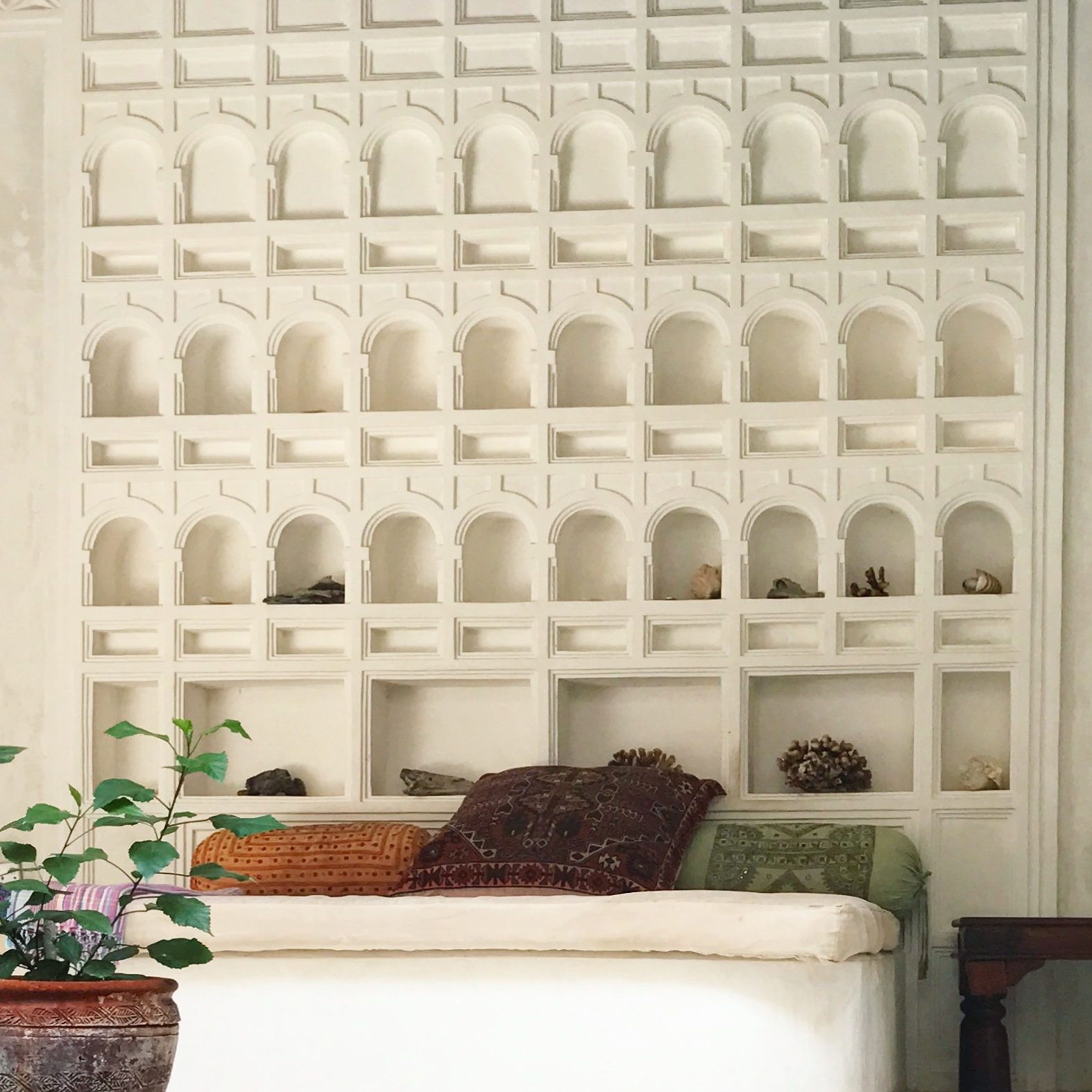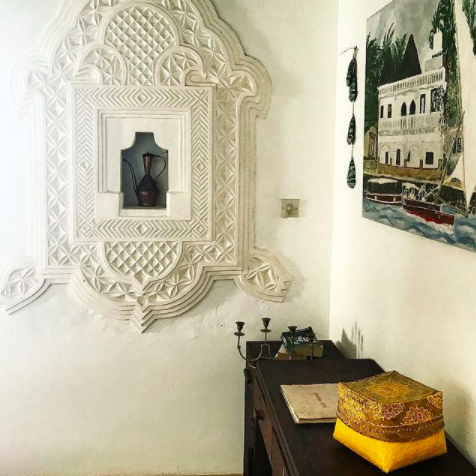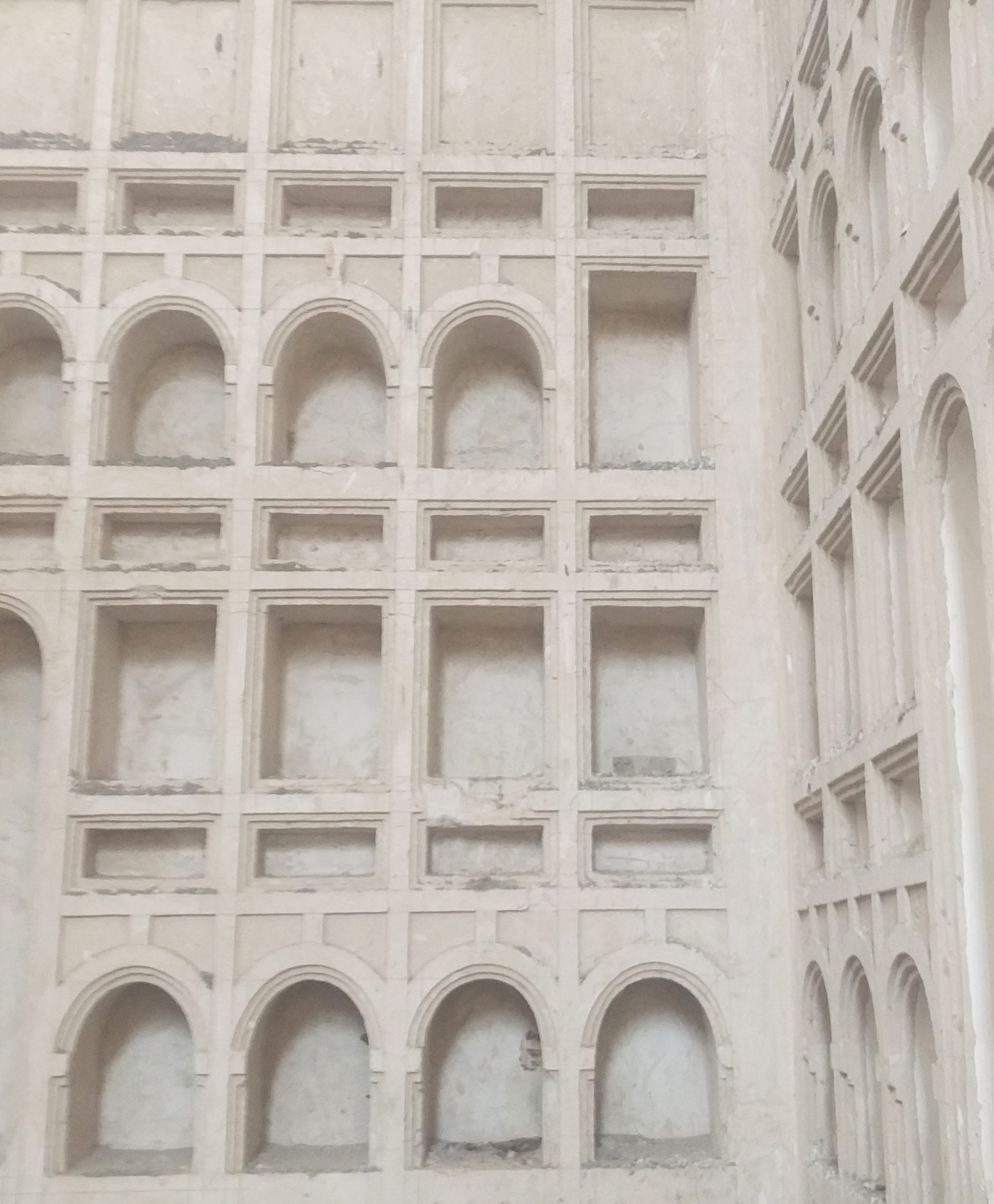Vidaka/Zidaka (singular: kidaka/idaka)1 are small niches carved into the walls of stone structures.
Vidaka comes from the root word daka, which translates into niche or indentation. Daka is also the name for the front porch in Swahili stone homes, which were nooks by the main entrance where male guests were received. The prefix ki- is used in the singular form of the word, making it a diminutive, which reflects a kidaka’s small size.

Vidaka were a mainstay in medieval Swahili architecture, and they date at least as far back as the 14th century. They waned in popularity in the 20th century, and were revived by plasterwork artists in the 1970s. The earliest vidaka still in existence are primarily found in ruins on the northern Swahili coast, in places such as Gede and the village of Siyu. Tomb ruins in Pemba Island, on the southern Swahili coast in present-day Tanzania, also contain the remnants of 14th-century vidaka. In medieval pillar tombs and palaces, rectangular vidaka were carved into the main structures’ surfaces, lining the tops of the walls and entryways.
READ MORE: The Art of Swahili Cooking
READ MORE: Changing Swahili Aesthetics Through The Eyes of Master Craftsmen
The most prevalent examples of medieval vidaka endure in Swahili stone house ruins. Patricians displayed imported decorative pieces, particularly Chinese porcelain and Islamic wares, inside rectangular or arched vidaka. The niches also held functional items, like Qur’ans, oil lamps, and water jugs. Individual vidaka peppered various walls of houses. When carved in singles, vidaka were cut into intricate shapes and surrounded by detailed plasterwork embellishments.

In northern Kenya, wealthy families installed the most dramatic vidaka arrangements in the innermost room of the house, called ndani. The ndani was the centre of intimate moments: it is where new brides were celebrated; where the man of the house and his wife slept; where newlyweds consummated their marriages; and where families prepared their deceased for burial and laid stillborns to rest.
In many homes, the ndani and its elaborate vidaka were visible from the courtyard. Often, vidaka covered the entire back wall of the ndani. More modest installations consisted of vidaka that bordered the ndani’s back door. Vidaka and the finery within them made stone houses’ narrow rooms appear grander due to their depth, making for a stunning visual backdrop for brides’ wedding day celebrations.
Vidaka, in the ndani, did more than just beautify the home and provide extra storage. Rooms in stone houses were long, narrow spaces that took up the entire width of the home. The rooms’ size and shape impacted the acoustics of the space, encouraging loud echoes and distorting sound. Vidaka and the objects arranged inside them acted as diffusers, reducing echoes in the private space and disseminating a more even and intimate sound. Vidaka carved into the wall thinned out the structure of the home and may have helped it maintain cool temperatures in the hot coastal climate.

Today, vidaka exist primarily in old homes on Lamu island. In the last two decades, many such homes have been sold to foreigners and renovated, and most new homeowners restore and maintain vidaka.
Families that still own old Swahili homes find even more practical uses for vidaka. One master plasterwork artist, Ahmed Yusuf Suleiman, finds that in homes where families raise pigeons, the niches act as makeshift bird nests.
Because of the cost of labour and material and changing trends along the coast, urban Swahili families don’t often commission the building of vidaka in their homes. Still, the craft is maintained and perfected by indigenous artisans, and residents of older stone homes generally leave them as-is.
FOOTNOTES
1The words vary depending on the dialect of Kiswahili.
Vidaka (plural) = Standardized Kiswahili (derived from Stone Town’s Kiunguja).
Zidaka (plural) = Kiamu (Lamu Town), Shikomori/Kingazidja (Ngazidja/Grande Comoros), and Kibajuni (Bajuni islands and coasts; pronounced dhidaka)
Kidaka (singular) = Standardized Kiswahili, Kibajuni, Kiamu
Idaka (singular) = Shikomori/Kingazidja
SOURCES:
– Abungu, G. H. O. ‘Pate: A Swahili Town Revisited’. Kenya Past and Present, vol. 28, 1996, pp. 50–60.
– Ahmed Yusuf Suleiman. 10 January 2021 12:15 AM EST. Whatsapp Message, used with permission. “…yes ecco [sic]. Because vidaka is in and out niches.”
––––. 10 January 2021 12:18 AM EST. Whatsapp Message, used with permission. “Kama nyumba ambazo wenyewe wafuga njiwa njiwa hupenda kutumia kama nyumba zao na kuzaa mayai hapo kwa vidaka.”
– Allen, James de Vere. ‘Swahili Culture Reconsidered’. Azania: Archaeological Research in Africa, vol. 9, no. 1, 1974, pp. 105–38.
– Baladouni, Vahan. ‘Apartment Therapy’. 5 Smart Solutions for Reducing Echo in Your Living Room and Beyond, 27 Mar. 2020, https://www.apartmenttherapy.com/how-to-reduce-echo-in-rooms-192737.
– Baumanova, Monika. ‘Pillar Tombs and the City: Creating a Sense of Shared Identity in Swahili Urban Space’. Archaeologies: Journal of the World Archaeological Congress, no. 14, 2018, pp. 377–411.
– Gensheimer, Thomas. ‘Swahili Houses’. The Swahili World, Routledge, 2017, pp. 501–12.
– Ghaidan, Usam. Lamu: A Study of the Swahili Town. East African Literature Bureau, 1975.
– Omar, Athman Lali, and Thomas H. Wilson. ‘Archaeological Investigations at Pate’. Azania: Journal of the British Institute in East Africa, vol. 32, no. 1, 1997, pp. 31–76.
– White, Paul. ‘Studio Acoustics’. The Producer’s Manual: All You Need To Get Pro Recordings and Mixes in the Project Studio, Sample Magic, 2012.
Wilson, Thomas H. Swahili Monumental Architecture and Archaeology North of the Tana River. National Museums of Kenya, 2016.





